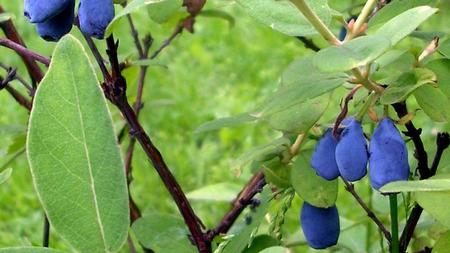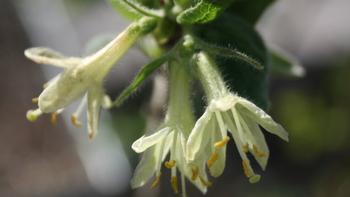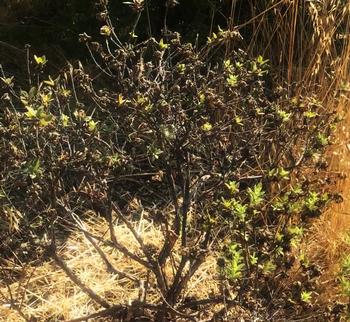News from the Edible Demo Garden
September 2022: Introducing the Honeyberry

What is a honeyberry?
The Honeyberry, Lonicera caerulea, is new to most American growers, but has a long history in the colder areas of the northern hemisphere. Most varieties originated in either Russia or Japan where it is called haskap. Its other name, edible blue honeysuckle, is a clue to its family membership. It is a non-invasive relative of honeysuckle, and its blooms look a lot like honeysuckle blossoms. it produces a nutritious edible fruit with a unique sweet-tart flavor. The fruit resembles elongated blueberries and is higher in antioxidants than blueberries. Honeyberries are delicate and don’t transport well, so don’t look for them in the grocery store.
What are the growing requirements for honeyberries?

- are cold-hardy and can tolerate clay and alkaline soils,
- require little yearly maintenance,
- grow best in full sun but may need protection in hotter climates,
- have shallow roots and need frequent watering until established,
- appreciate being mulched to protect the roots,
- usually need a honeyberry bush of a different variety nearby for cross-pollination,
- like many perennial fruiting plants, require a certain number of chill hours to produce fruit.
Can a honeyberry bush be successfully transplanted?

Transplanting an established bush around four feet in height and width took some planning and effort. Care was taken to protect the roots by digging deeply around the bush perimeter and cautiously removing as much of the root ball as possible. The new site was excavated and watered well, and the honeyberry bush was nestled into its new home. Drip irrigation was added in order to provide adequate water for the roots to reestablish. Five months have passed, and the honeyberry bush is still alive but showing some stress. It’s too soon to know if the transplant was successful.
Tempted to try growing honeyberries?
You probably won’t find honeyberry plants in local nurseries, but there are many varieties available from growers online. Since honeyberries originated in cooler climates, it’s important to select varieties with the lowest number of chill hours. You will also need at least two plants of different varieties that bloom at the same time. Growing your own unique tasty fruit could be worth the challenge.
